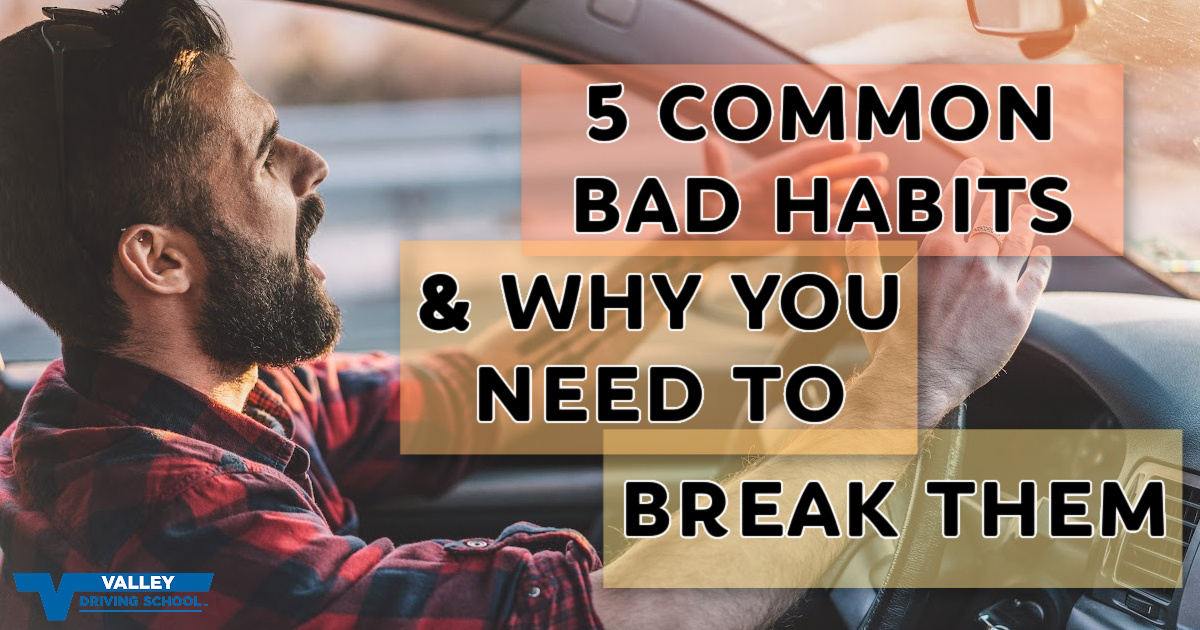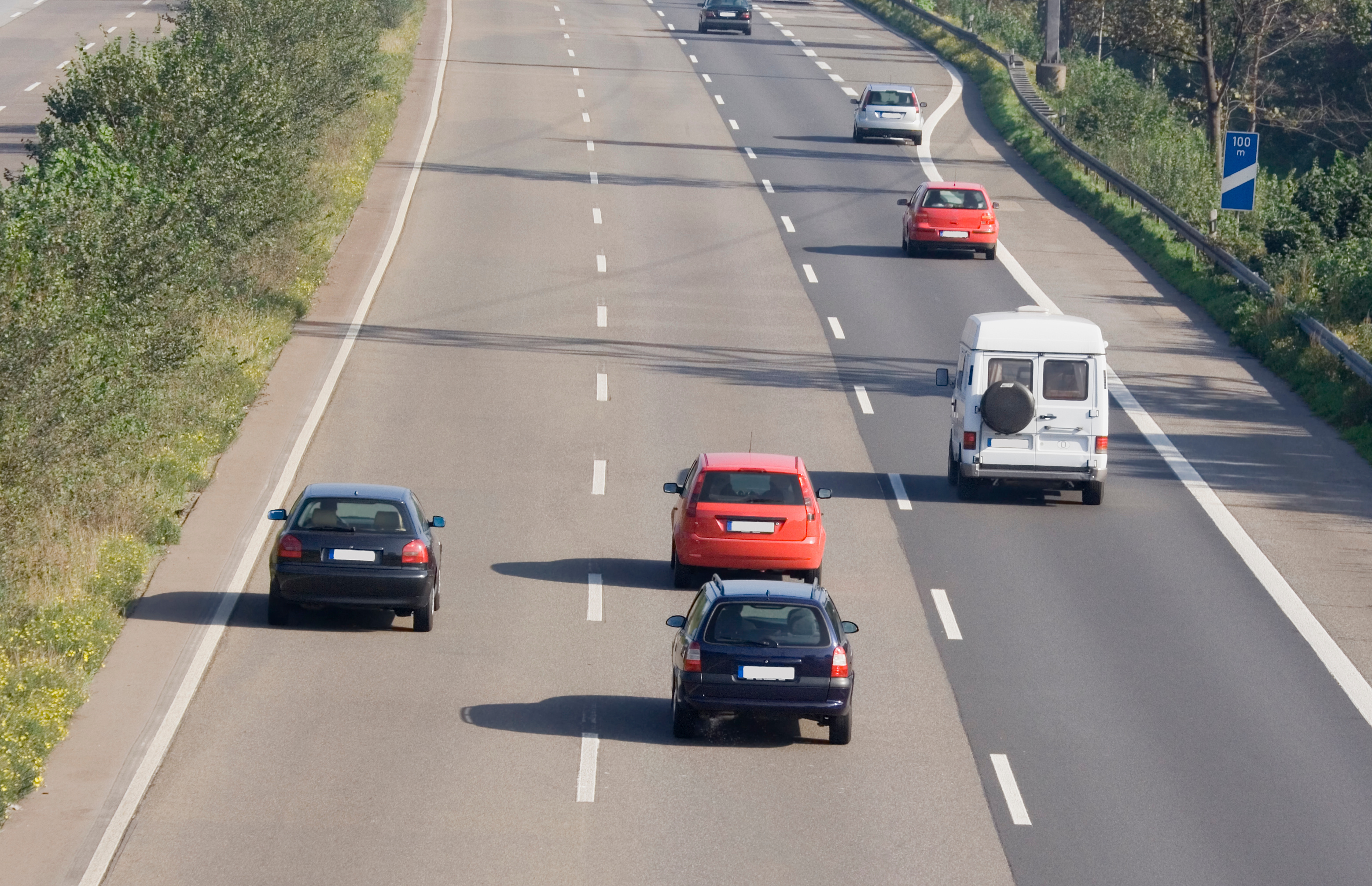After you’ve been driving for a while and start to develop some confidence behind the wheel, it’s not uncommon to pick up a few bad habits along the way. While we sometimes shrug them off as trademarks of our own personal driving style that don’t affect anyone, the combination of thousands of drivers with a few bad habits can easily equate to an increased number of accidents.

In this post, Valley Driving School’s own on-road and classroom Instructor Leah Dyck, sheds some light on a few common bad driving habits and why you need to break them.
Tailgating
 Tailgating is not always a byproduct of road rage. Some drivers don’t realize how close they are to the vehicle in front of them and get too comfortable being so close to other vehicles. I truly believe leaving more space between vehicles is one of the easiest and most effective methods to reduce the number of accidents on our roadways.
Tailgating is not always a byproduct of road rage. Some drivers don’t realize how close they are to the vehicle in front of them and get too comfortable being so close to other vehicles. I truly believe leaving more space between vehicles is one of the easiest and most effective methods to reduce the number of accidents on our roadways.
As a driver trainer, I always teach my students to maintain a safe following distance at all times. A safe distance is:
- Minimum 2 seconds following distance in the city
- 3-4 seconds following distance on the highway
Following distances are calculated by choosing and focusing on a fixed object ahead of you. When the vehicle in front of you passes that object, begin counting the seconds (one one-thousand, two one-thousand) until you reach the same fixed object to determine your following distance.
If you do this and you’re only able to get to “one, one-thou”, you’re too close for any and all roadways!
The appropriate amount of space gives drivers more time to react. Do yourself a favour and always give yourself that time.
Forgetting Those Shoulder Checks
Ah yes, the ‘ol shoulder check. The thing you’re supposed to do every time you change lanes or make a turn. Sadly, this is another maneuver that is forgotten all-too-often. New technology has equipped our vehicles with blind spot detectors which can be very helpful - but they should never be a replacement for safe driving practices.
Shoulder checks are one of those things we do hundreds of times that seem totally pointless until you do a shoulder check and someone is directly in your blindspot. A shoulder check is a simple maneuver, not a full body stretch, twist, and contortion. I’ve seen some pretty intense shoulder checks, and they really don’t need to be so involved. All you need to do for an effective shoulder check is bring your chin to your shoulder so you can see your blind spots - you don’t have to crack your spine to do it.
Making a left turn? Just before you make that turn, bring you chin to your left shoulder checking your blind spot for any hazards or pedestrians. Always shoulder check in the direction you are heading.
Going LEFT? Shoulder check LEFT. Going RIGHT? Shoulder check RIGHT. It’s that simple, and generally shoulder checks only need to be done once per turn.
Grabbing the Inside of the Steering Wheel (AKA Hooking)
I see this all the time. Try this little experiment right now:
- Hold your right arm out in front of you at a 90-degree angle with your palm facing your face.
- Pretend you are making a left turn, pulling your palm down to your chest.
- Gauge your range of motion. Did you have issues making that small maneuver?
- Trying the same thing again, this time pull your arm down to the right.
How did that feel? Can you do it? I personally don’t know of anyone who can.
Picture this: you’re making a left turn and your hand is on the inside of the steering wheel. A pedestrian makes a last minute leap out in front of you and you have to steer right to avoid them. Can you do it? Probably not. Not only does gripping the inside of the steering wheel give drivers very little steering control, if your air bag were to deploy - guess what else is flying at your face? Your arm.
Always keep your hands on the outside of the steering wheel. Not only does it give you control to make any kind of steering adjustment, it also keeps your hands and arms away from your face should your air bag deploy.
Forgetting to Use Your "Blinker"/turn signal
As we hurl ourselves forward at speeds of 50/70/100+ km/hr, it’s crucial that we communicate with other road users. If only our vehicles were equipped with some kind of special device to communicate with other drivers… Oh wait; turn signals.
Many of my students often ask me, “do I need to signal here?” My response is usually, “would it help clarify what our intentions are?” The answer is often yes.
We are all on the roads together, so let’s make driving and communicating with each other as safe and easy as possible for everyone. When in doubt, put your signal on. Bottom line: use your turn signals to communicate with other road users.
All or Nothing Driving
A lot of drivers are either heavy on the accelerator, or heavy on the brake all the time. However, there are times when you don’t need to be pressing on either pedal.
Your vehicle will naturally start slowing down without braking. When a situation arises where you need to increase your following distance, slow down for a lower speed limit, or begin slowing down for the red light ahead, simply take your foot off the accelerator and let the vehicle slow down naturally.
 When we see brake lights ahead of us, our first reaction is to add brakes - however - as soon as we do this we start a chain reaction of brake lights behind us. Sometimes it can be necessary if we are approaching a red light or need to be at 30km/h for an approaching school zone, but when we are on the freeway travelling at 100km/h we really don’t want to be flashing our brakes lights if it’s not necessary.
When we see brake lights ahead of us, our first reaction is to add brakes - however - as soon as we do this we start a chain reaction of brake lights behind us. Sometimes it can be necessary if we are approaching a red light or need to be at 30km/h for an approaching school zone, but when we are on the freeway travelling at 100km/h we really don’t want to be flashing our brakes lights if it’s not necessary.
Simply taking our foot off the accelerator and covering the brake pedal with our right foot is often sufficient. It’s also much more fuel efficient, easier to increase your speed, and stops the brake light chain reaction.
These are just a few of the most common driving errors many driving instructors encounter on a regular basis. Challenge yourself to break these bad habits and see how much your driving improves!
